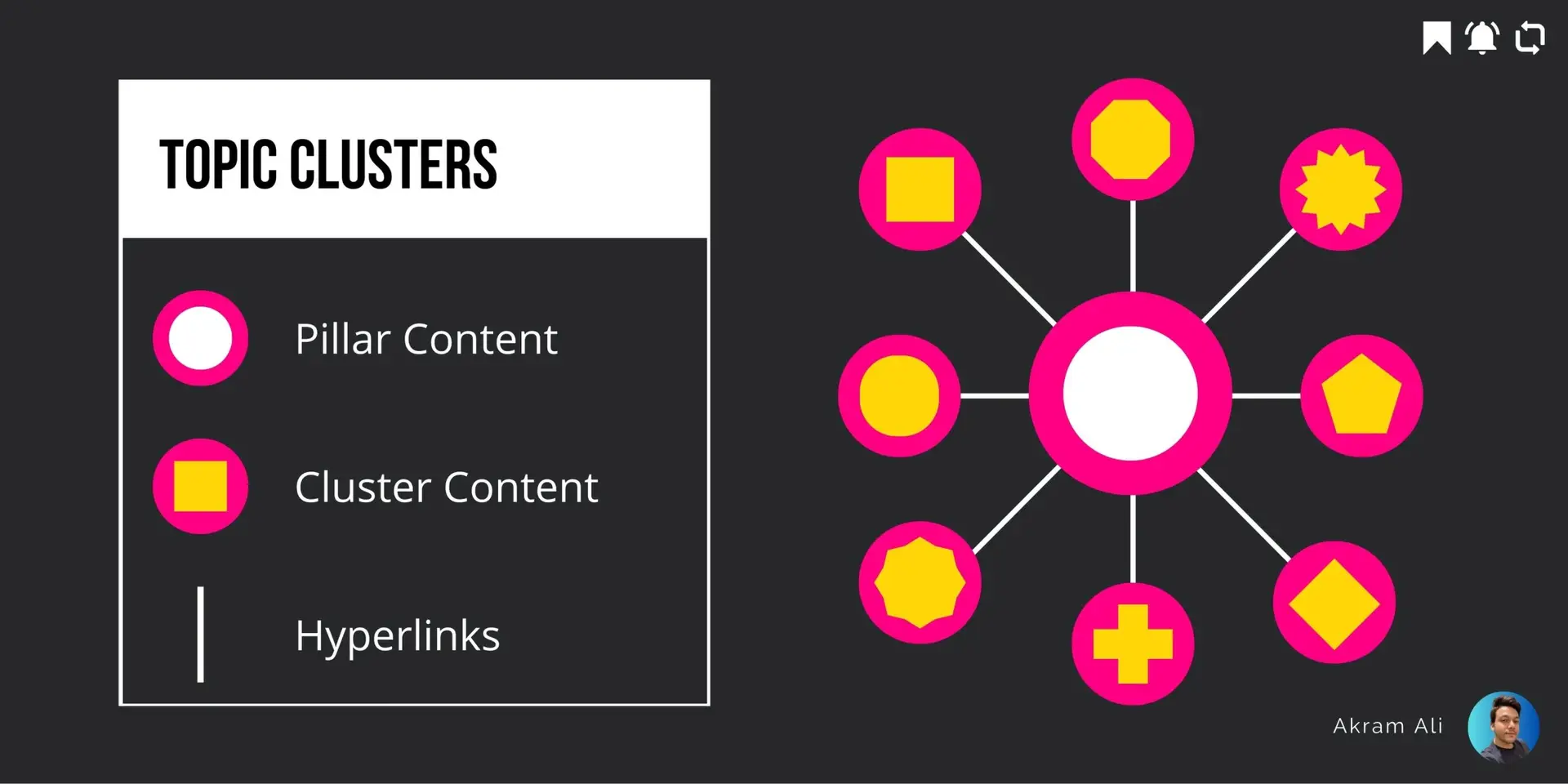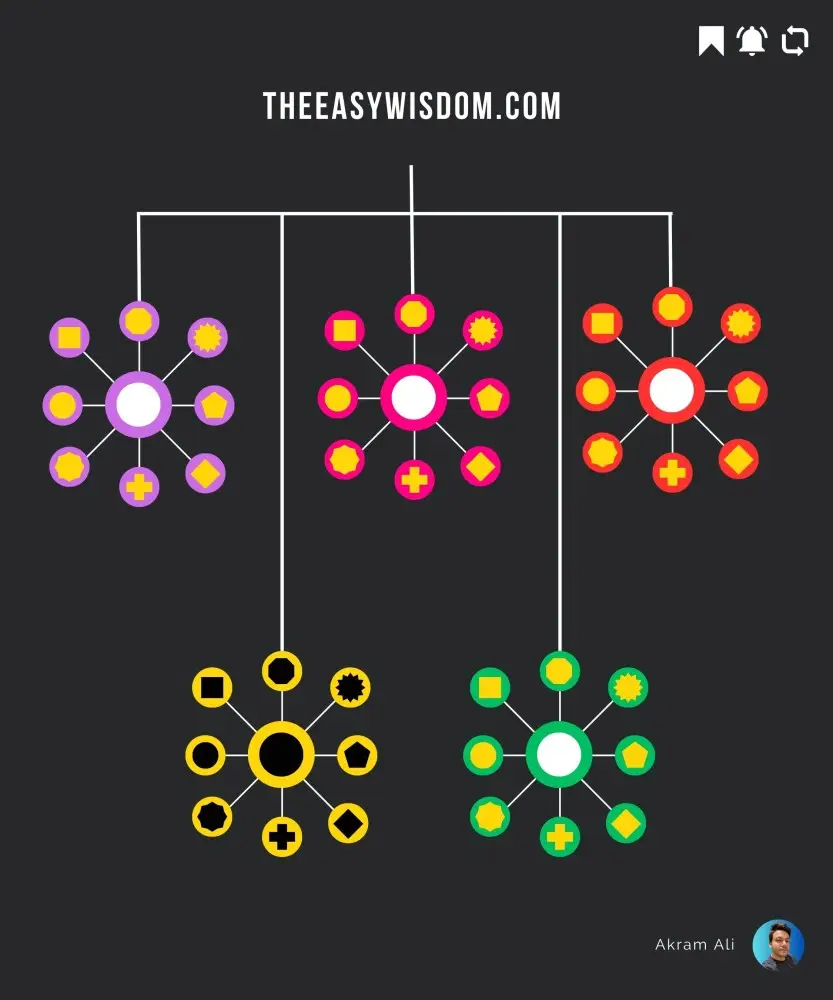Tl;DR
A topic cluster is a strategic approach to organizing and linking related content on your website. It revolves around a central “pillar page” that covers a broad topic comprehensively. This pillar page serves as the nucleus of the content cluster, providing in-depth information and acting as a comprehensive resource for visitors.
Within the topic cluster, multiple supporting blog posts orbit around the pillar page, exploring specific subtopics in detail. These blog posts are linked to the pillar page and each other, creating a network of interconnected content that enhances the user experience and search engine visibility.
Search engines like Google have changed their algorithms to favour topic-based content.
As a result, all the neo-age websites are exploring this new way of linking related content under a “topic cluster” model to establish their topical authority.
Yes, SEO is now shifting to a topic cluster model.
A study by HubSpot found that websites with topic clusters saw a 43% increase in organic traffic.
Also Read: What is Reverse SEO? How Does It Help Manage Online Reputation?

What are the advantages of using the topic cluster method to organize your content architecture?
Here are the advantages of using the topic cluster framework for organizing your content:
Establishes Your Topical Authority
This framework establishes your topical authority, both in the eyes of users and search engines.
By adopting a topic cluster approach, you signal to search engines that your website covers a subject or topic comprehensively. The search engines, in turn, reward your website by improving visibility and achieving higher search rankings.
Additionally, topic clusters help establish your authority and thought leadership in your niche. You showcase your expertise and build trust with your audience by providing valuable content around a central topic. As a result, your content helps you position yourself as a go-to resource in the industry, fosters brand loyalty and evangelism, and encourages repeat visits.
A study by Semrush found that websites with topic clusters have an average of 15% higher domain authority than websites without topic clusters.
Enhances User Experience on Your Website
The topic clusters approach enhances the user experience by offering visitors a rich tapestry of related information. When users land on your pillar page, they can easily navigate to relevant cluster blog posts that dig deeper into their interests. This streamlined user journey fosters engagement, increases time spent on your website, and reduces bounce rates. These are all positive user experience signals the search engines sense and, in turn, reward you by listing you higher on the SERPs for relevant search queries.
Help Rank Your Blogs For High Keyword Difficulty (KD) Keywords
The topic cluster approach helps you gain traffic on the cluster pages that have been optimized for keywords that have lower search volumes and long-tail keywords. The pillar page content, optimized for short tail, high search volume, and high KD keywords, in turn, drives more traffic for these competitive keywords with time, making your rank higher on the SERPs for high KD keywords. This enhances your website’s SEO and increases organic traffic.
Leads to a Better Website Structure
Implementing topic clusters enhances website structure, making it easier for users to navigate and find relevant content.
Helps You Move From Keyword-Focussed Linking To Contextual Internal Linking
Topic clusters facilitate contextual internal linking within a website, offering a structured alternative to keyword-focused linking strategies. This is because topic clusters organize content around comprehensive topics rather than individual keywords, aligning with user intent and experience.
What is the topic cluster model?
The topic cluster model is a way of organizing a site’s content pages using a cleaner and more organized site structure.
This model organizes the content into two elements:
- The core topic or the pillar page
- The supportive topics or subtopics, called cluster pages
The pillar page, or pillar post, acts as the central hub of content for a broad topic. They provide a comprehensive overview of a broad topic and link to related content pieces.
Multiple content pages or cluster pages that are related to that topic link back to the pillar page.
This linking signals to search engines that the pillar page is an authority on the topic, and over time, the page may rank higher for the topic it covers.
Treat the topic cluster model as that of the hub-and-spoke model, where the pillar page is the central hub, linking to the supporting blog posts. Each blog post can link to the pillar page, creating a structured and interconnected network. This model reinforces the topical relevance and strengthens the overall authority of your cluster.
Topic clusters rearrange a website’s structure to look more like the image below. Clusters of content that cover a topic area link to a central pillar page that definitively — yet broadly — outlines the topic.

Example of Topic Cluster Approach
Let me explain this with the help of an example.
Suppose you want to create a topic cluster on “content marketing.”
Your pillar page could be a complete article covering content marketing. Among other topics you would cover on this page could be a content marketing strategy, content marketing for lead generation, content marketing for small businesses, content marketing for building a personal brand, content marketing ideas, etc.
The pillar page is generally a piece of content with high KD (keyword difficulty) that you want to rank for.
This page will cover a specific topic in a lot of detail, written in a well-organized, long-form content style, with headings, subheadings, topics, subtopics, a table of contents, etc.
The goal of any pillar page is to be the most authoritative, high-quality content in the eyes of search engines for a given keyword.
From your pillar page, you would add links to cluster pages. These would dive deeper into the topics mentioned on your pillar page. For example, these cluster pages or sub-topics could be:
- Content marketing strategy
- Content marketing for lead generation
- Content marketing for small businesses
- Content marketing for building a personal brand
- Content marketing ideas
- Content marketing for content creators
These pages cover one particular subtopic in much more detail than the pillar post, have a lower word count, and cover a smaller part of the overall topic. In many cases, they cover long-tail keywords or informational keywords, generally with a lower KD.
These supportive topic pages could cover subtopics such as:
- “How to..”
- “What..”
- “Where..”
- “Who..”
- “Why..”
- “..vs..” etc.
So, while the core topic covers every aspect of content marketing, a supporting page might only answer one question in relation to the primary topic, for example:
– “How does content marketing help businesses?”
– “Where to start with content marketing?”
– “Is content marketing worth it?”
– “Why content marketing is important?”
– “AI tools for content marketing”
– “Content marketing strategy for doctors”


As a general guideline, aim to have around 20 supporting blog posts within your topic cluster. This number provides enough depth and breadth to cover subtopics and establishes a substantial cluster of interconnected content.
How can the topic cluster model help you rank for keywords with high KD?
The topic cluster approach helps you gain traffic on the cluster pages that have been optimized for keywords that have lower search volumes and long-tail keywords.
Optimized for short tail, high search volume, and high KD keywords, the pillar page content drives more traffic for these competitive keywords with time, making your rank higher on the SERPs for high KD keywords.
Let’s understand this with an example:
Let’s say you need to rank higher on the SERPs for a blog post for a particular keyword, such as “SEO.” This keyword has a great search volume of 1,10,000 per month in the US, but the KD is very high, viz. 82.
So, you adopt a topic cluster approach or framework on your website for this keyword “SEO.” You create a pillar page on SEO that comprehensively covers this topic and associated topics such as technical SEO, link building, and local SEO.
From this pillar page, you add links to cluster pages that would dive deeper into the topics mentioned on your pillar page, such as keyword research for local SEO, link building for blog websites, technical SEO, etc.
So, you have the core topic you want to rank for (the pillar page) and the sub-topics (the content clusters or supportive topics) ready with you.
Now, you should link the supporting pages to each other using exact-match keywords as anchors. Plus, you need to ensure that each topic cluster or supporting page links back to the core topic using an exact match keyword as an anchor.
This internal linking structure is crucial to creating a working topic cluster.
When you do everything correctly, including a proper internal linking structure, Google will see lots of thematically related pages linking to each other. Each page also gives SEO juice to the core topic by linking to it, helping the core topic with a higher KD get a higher position in the SERPs.
How do you implement a topic cluster model on your website?
Here are the steps you should follow:
To restructure the existing content, follow these steps:
- Audit your existing content to find pages created around a central theme, which you can organize into pillar posts and sub-topic clusters.
- Conduct in-depth keyword research to map out 5–10 core problems your buyer personas face and identify short-tail and long-tail keywords related to the same. Map out content ideas that align with each of the core topics and corresponding subtopics.
- Optimize the identified pillar page for a relevant keyword with a high KD on which you want to establish your topical authority and rank in the SERPs. This page should be comprehensive and must contain associated topics related to the main keyword your user personas are searching for covered in detail.
- Optimize your cluster pages for each sub-topic explored in the pillar page. These would dive deeper into the topics mentioned on your pillar page. You need to optimize your cluster pages for the long-tail keywords related to the subtopic in question.
- Link the supporting pages to each other using exact-match keywords as anchors. Also, make sure that each topic cluster or supporting page links back to the core topic using an exact match keyword as an anchor.
- Ensure metadata optimization by including titles, descriptions, and headers that reflect the topic cluster structure.
- Hit update. Measure the impact after a few months and refine.
To implement the topic-cluster method from scratch, follow these steps:
- Choose a Core Topic: Select a broad topic relevant to your website’s niche.
- Identify Subtopics: Brainstorm related subtopics that can expand on the core topic.
- Keyword Research: Conduct keyword research to find terms related to your core topic and subtopics. The core topic can be short- to medium-tail, with a high KD keyword. The sub-topics could be long-tail keywords or ultra-long-tail keywords.
- Create Pillar Content: Develop comprehensive content covering the core topic, serving as the pillar for your cluster.
- Develop Cluster Content: Generate content for each subtopic, linking them back to the pillar content and each other.
- Internal Linking: Link cluster content to the pillar page and vice versa to establish connections within the cluster for the right anchor texts.
- Optimize Metadata: Ensure metadata, including titles, descriptions, and headers, reflect the topic cluster structure.
- Regularly Update Content: Keep cluster content relevant and up-to-date to maintain its SEO value.
- Track Performance: Monitor the performance of your topic clusters using analytics tools and adjust strategies as needed.
- Iterate and Improve: Continuously refine your topic cluster model based on performance metrics and audience feedback.
Suggested Reading: Topic Clusters for SEO: What They Are & How to Create Them
Thank you for reading.
Sound off with your thoughts!
I’m all ears.
Sharing is caring: 📌 If you like this post, please share ♻️ and show your support! 👈 ✅
Follow me on LinkedIn for amazing Digital Marketing Tips 😍🚀


[…] Read Also: Topic Clusters Framework For SEO & Content Marketing […]